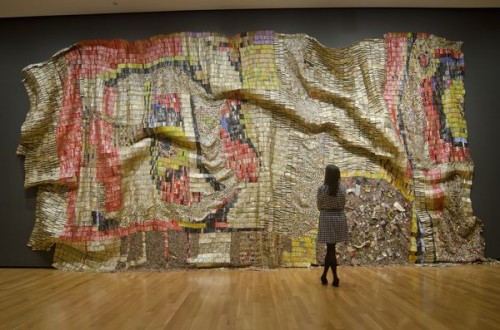
El Anatsui. “Earth’s Skin,” 2007. Aluminum and copper wire, 177 x 394 in. Courtesy the artist and Jack Shainman Gallery, New York. Courtesy of the Akron Art Museum. Photo: Joe Levack.
Gravity and Grace: Monumental Works by El Anatsui at the Brooklyn Museum marks the first solo exhibition in a New York museum of Anatsui’s art. Featuring over thirty works by the Ghanaian-born artist, Gravity and Grace is a magnificent show, and one particularly suited to illuminate the nuances of this month’s “network” theme. “Network” is a somewhat nebulous term that can refer, on the one hand, to a formal arrangement of intersecting lines made of fabric, wire or cord, and, on the other hand, to a broader system of interconnected persons or things (computers, social groupings, global markets, etc.). El Anatsui’s oeuvre resides at the nexus of both senses of the word.
Anatsui, who currently lives and works in Nsukka, Nigeria, has exploded onto the global art stage over the course of the past ten years, and with good reason. He is best known for his use of found materials—primarily tin cans and aluminum screw-top caps and bands from liquor bottles—which he flattens, folds, and stitches together into monumental curtains of sumptuous color and pattern. The first work visitors encounter is Gli (Wall), a multipart work suspended from the ceiling in an atrium.
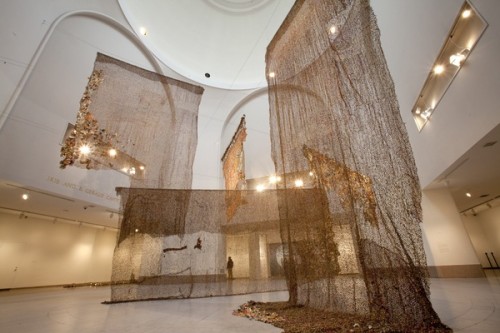
El Anatsui. “Gli (Wall),” 2010. Installation view at the Brooklyn Museum. Photo: JongHeon Martin Kim.
Comprised of folded, creased and compressed liquor caps and bands discarded by Nigerian distilleries, Anatsui transposes these humble objects into majestic, translucent scrims of color and texture. Another work, Red Block, measures approximately sixteen by ten feet and consists of thousands of flattened red bottle caps that have been sutured together by copper wire into a cascading drapery of opulent, monochromatic color. Like many of the artist’s works, Gli (Wall) and Red Block convey a delicate balance between individual elements and overall structure, as the multitude of small metal caps fuse into a unified whole. If the term “network” refers in one sense to the arrangement of interlinked fabric, then Anatsui’s metallic sculptures are just that: malleable networks of cast-off flotsam banded together into intricate, textile-like tapestries of metal.
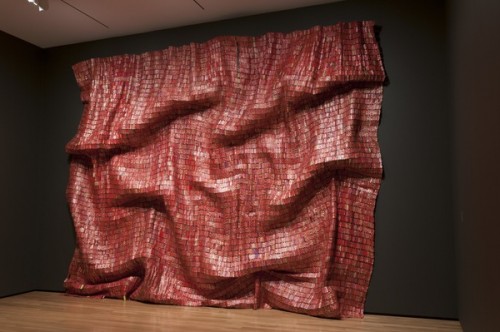
El Anatsui. “Red Block,” 2010. Aluminum and copper wire, two pieces, each 200 3/4 x 131 1/2 in. Courtesy the Broad Art Foundation.
But the true revelation of this show, aside from the enchanting beauty of the artist’s colorful and inventive objects, is that Anatsui’s work is as conceptually rigorous as it is visually compelling. In transforming the lowly bottle cap and tin can into monumental sculpture, Anatsui creates works whose symbols and patterns draw from and are inspired by a diverse range of African textile traditions—from kente cloth to Akan adinkra funerary cloth—but that also gesture beyond such regional references to the intricate histories of modern trade and the networks of global commerce. For Anatsui, the liquor bottle cap is not simply a pliable substance but a material freighted with meaning, alluding to alcohol’s central role in the centuries-old exchange and barter systems between Europe and Africa, as well as its status as an important commodity in the transatlantic slave trade.
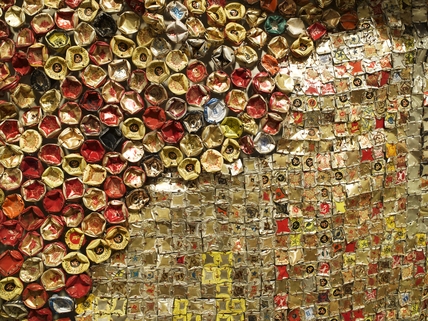
El Anatsui. “Gli (Wall),” (detail), 2010. Aluminum and copper wire, installation at the Brooklyn Museum, dimensions variable. Courtesy the artist and Jack Shainman Gallery, New York.
There are more contemporary references to patterns of consumption as well. In Peak and Drainpipe, Anatsui uses tins and lids from Peak Milk, a brand of condensed milk produced in the Netherlands and sold in West Africa. Peak and Drainpipe speak to the particularities of regional packaging but also to the consequences of consumption in places where recycling technology is limited and piles of waste dot the landscape. Through bottle caps, tins and other found objects, Anatsui gestures beyond formal considerations to complex economic and sociological relations. In them one senses the predicates of desire (individual, consumer, colonial and post-colonial) and with it the quiet tug of inequities and consequence of networks of exchange straddling oceans and centuries.
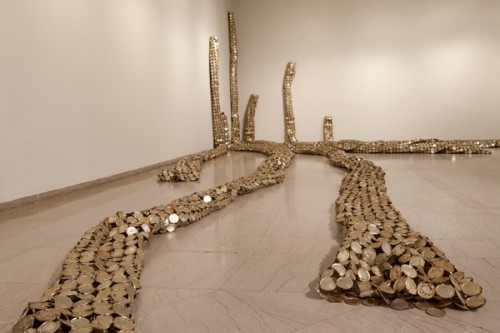
El Anatsui. “Drainpipe,” 2010. Tin and copper wire, installation at the Akron Art Museum, dimensions variable. Courtesy the artist and Jack Shainman Gallery, New York. Courtesy of the Akron Art Museum. Photo: Andrew McAllister.
Appropriating rubbish that obliquely gestures to cross-cultural exchange among Africa, Europe, and the Americas, Anatsui synthesizes regional customs and global realities and imbues his beautiful abstractions with an undercurrent of economic, political, and sociological allusion. But his choice of universal materials also leaves his work open to multiple avenues of speculation and interpretation, the artist skillfully avoiding the blunt expository ambition that can at times doom contemporary art. Instead, Anatsui’s vibrant sculptural scrims reveal as much about patterns of history, trade, and consumption as they do regional or cultural aesthetics without one overshadowing the other. While providing insights into his own history and African textile traditions, Anatsui also shows us more about the world writ large than we might expect in such achingly beautiful works.
Gravity and Grace: Monumental Works by El Anatsui is on view at the Brooklyn Museum through August 18, 2013.



